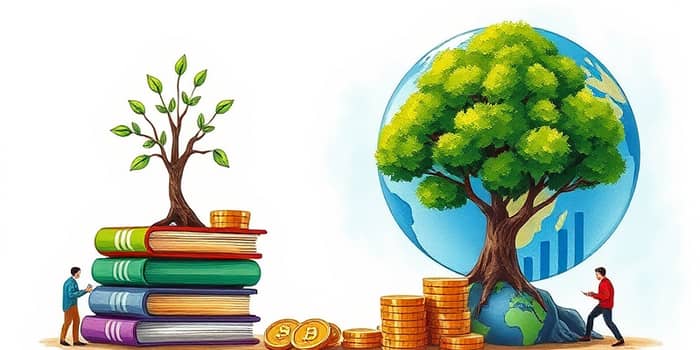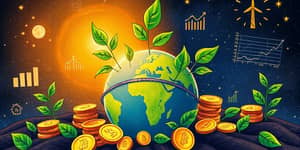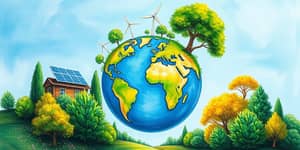In recent years, exchange-traded funds (ETFs) focused on environmental, social, and governance (ESG) criteria have surged in popularity. Investors worldwide are increasingly seeking ways to align their portfolios with personal values, driving an unprecedented expansion in sustainable ETF offerings. This comprehensive article explores the drivers behind this growth, the types of sustainable ETFs available, key challenges, and actionable insights for those looking to navigate this dynamic landscape.
By understanding market momentum and emerging trends, you can position your investments for both financial return and positive impact.
Understanding the Surge in Sustainable ETFs
The sustainable investing sector experienced a remarkable 15.2% growth in 2024, reflecting a broader shift toward responsible capital allocation. As of 2025, assets under management in ESG-aligned ETFs and mutual funds exceed $350 billion in assets, up more than threefold since 2018. Retail investors, in particular, are fueling this expansion, with 63% of U.S. investors planning to add ETFs to their portfolios in the coming year, compared to just 37% in 2022.
This momentum extends globally: Australian investor interest jumped from 36% to 72% in the same period, underscoring the universal appeal of sustainable strategies. The migration of assets from mutual funds to ETFs continues, driven by ETFs’ transparency, liquidity, and tax efficiencies.
Exploring Types of Sustainable ETFs
The diversity of sustainable ETF offerings has never been greater. Investors can choose from a wide spectrum of strategies that cater to different risk appetites and impact goals.
- ESG-Screened Broad Market ETFs: These replicate mainstream indexes (S&P 500, MSCI World) with additional screens to exclude controversial weapons, fossil fuels, tobacco, and more.
- Clean Energy ETFs: Focus on renewables such as wind, solar, and hydroelectric power, capturing growth in companies driving the energy transition.
- Green Technology ETFs: Target firms innovating in energy efficiency, emissions control, and waste reduction technologies.
- Niche Thematic ETFs: Emerging themes include biodiversity conservation, sustainable agriculture, and waste management solutions.
Thematic specialization allows investors to zero in on specific environmental challenges, while broad-market options provide diversified exposure to the entire sustainable economy.
Key Industry Drivers and Trends
Several factors are propelling the continued rise of sustainable ETFs. Demographically, younger investors—Millennials and Gen Z—prioritize social impact alongside financial returns. This cohort is driving demand for products that offer both performance and purpose.
Regulatory evolution is another major catalyst. The U.S. Department of Labor’s consideration of climate-related risks as fiduciary concerns, along with similar frameworks in Europe, is pushing fund providers toward clearer disclosure and definitions in their ESG methodologies. Experts forecast a 21% growth in ESG and sustainability ETF categories over the next year.
Innovation in product design—including active strategies and AI-driven ESG scoring—continues to diversify the market. Global expansion is also notable, as operational barriers fall and more regions adopt retirement channels that accommodate ETF investments.
Assessing Challenges and Considerations
Despite the optimism, sustainable ETF investors must navigate several pitfalls. Greenwashing risk remains a top concern: funds with nominal ESG labels can mislead investors without robust, transparent methodologies. Careful due diligence is required to ensure fund managers apply credible screening processes.
The debate between passive versus active ESG strategies centers on impact. Passive ETFs track indexes and may lack direct engagement with companies, while active funds often aim to influence corporate behavior through shareholder voting and engagement.
Performance and volatility also warrant attention. Some ESG ETFs have outperformed conventional peers, but during sector rotations—particularly when high-emitting industries rebound—certain sustainable funds may underperform. Rapid policy shifts can further affect fund labeling and eligibility.
Market Leadership: Top Sustainable ETFs
For investors seeking benchmarks, the following table highlights leading sustainable ETFs by category and recent returns:
Strategies for Investors: What to Watch
When evaluating sustainable ETFs, keep these guiding principles in mind:
- Analyze portfolio diversification: Ensure the fund aligns with your overall asset allocation and risk tolerance.
- Scrutinize ESG methodologies: Review screening criteria, engagement approaches, and third-party ratings.
- Consider cost and liquidity: Lower expense ratios and strong trading volumes can enhance net returns.
- Monitor regulatory developments: Be prepared for evolving disclosure requirements and labeling standards.
Incorporating sustainable ETFs into a long-term strategy can deliver both market returns and meaningful environmental or social impact. By focusing on transparent, credible ESG methodologies, investors can mitigate greenwashing risks while supporting positive change.
Looking Ahead: The Future of Sustainable ETFs
The outlook for sustainable ETFs remains robust. As global attention on climate change, social justice, and corporate accountability intensifies, demand is set to rise. Future product innovation may include deeper integration of alternative data, bespoke active strategies, and expanded thematic niches.
While specialized funds—focused on biodiversity, water, or waste management—offer targeted impact, investors should watch for liquidity constraints and critical mass. Collaborative initiatives between asset managers, regulators, and non-profits will be crucial in defining standardized ESG metrics and preventing greenwashing.
Ultimately, sustainable ETFs represent a powerful vehicle for channeling capital toward a more equitable and resilient global economy. By staying informed and vigilant, investors can harness this trend to pursue both financial success and a lasting, positive legacy.
References
- https://www.homaio.com/post/sustainable-etfs-how-to-invest-in-responsible-funds-in-2025
- https://www.ey.com/en_gl/insights/financial-services/emeia/how-etf-trends-are-shaping-market-growth-and-innovation-for-2025
- https://www.deloitte.com/us/en/insights/industry/financial-services/financial-services-industry-predictions/2025/etf-growth-market-opportunities.html
- https://www.statestreet.com/hk/en/insights/etfs-2025-outlook
- https://www.corporateknights.com/category-finance/meet-the-four-most-sustainable-funds-on-the-market-for-2025/
- https://sustainablefinancedaily.com/sustainable-finance-insights/investing/investing-in-a-greener-future-a-comprehensive-guide-to-sustainable-etfs/
- https://www.investopedia.com/investing/rise-socially-responsible-etf/










